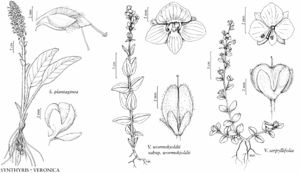Synthyris plantaginea
Prodr. 10: 455. 1846.
Leaves strictly annual, disintegrating in 1st year; blade narrowly to broadly ovate, 25+ mm wide, leathery, base obtuse to rounded or lobate, margins crenate, teeth apices acute to obtuse, surfaces sparsely hairy to villous; basal veins extending through proximal 1/2 of blade, lateral-veins 5–12 on each side of midvein. Racemes erect, to 40 cm in fruit; sterile bracts 9–31, ovate-spatulate, largest 1+ cm; flowers 100+, densely aggregated (separating in fruit). Sepals 4. Petals (3 or) 4 (or 5), apex entire or erose; corolla pink to white, bilabiate, ellipsoid, 0–2 mm longer than calyx, glabrous or sparsely hairy, lateral and abaxial petals of abaxial lip connate 1/2+ their lengths, tube absent. Stamens inserted on receptacle. Ovaries glabrous; ovules 17–40. Capsules glabrous.
Phenology: Flowering May–Jun; fruiting May–Aug.
Habitat: Montane to subalpine meadows, open, montane, conifer forests.
Elevation: 1800–3400 m.
Distribution
Ariz., Colo., N.Mex., Wyo., Mexico (Chihuahua)
Discussion
Both diploid (2n = 24) and tetraploid (2n = 48; described as Besseya gooddingii Pennell) populations have been discovered among southern populations of Synthyris plantaginea in Arizona (C. G. Schaack 1983). Synthyris plantaginea is a host for the checkerspot butterfly (Euphydryas anicia), which sequesters iridoid glycosides as it consumes the leaves (K. M. L’Empereur and F. R. Stermitz 1990).
Selected References
None.
